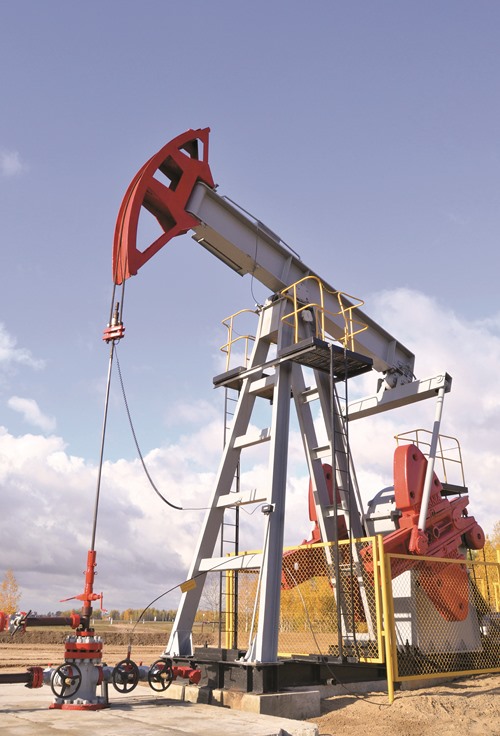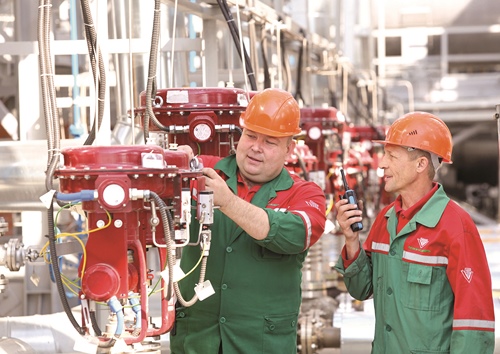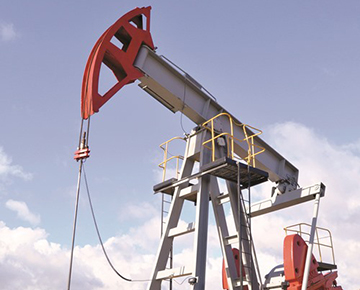Everyone knows that oil is the most important fuel for the economy of any country, but most only have a rather vague idea of how this strategic resource is being discovered and produced. This fascinating process is associated with the latest technology and an enormous amount of work. In the industry’s 50th anniversary year, these heroes of our time have lifted the veil of ‘trade secrets’ to show us the key features of national oil production. Details in the MT report below.

In Rechitsa — the oil workers city
From Belorusneft headquarters in Gomel we set a course for Rechitsa oil field. Half a century ago the first commercial inflows of hydrocarbons were produced here, and over the years the district centre has slowly turned into an oil town. Of particular interest is the fact that, in the post-Soviet era, Belorusneft is the only oil producing company that has fully retained its structure despite the turmoil of the 1990s. This has helped it to keep up with the times.
At the wellsite, journalists are received by the Head of the Svetlogorsk Drilling Department, Vladimir Krizhanovsky. All oil wells in the country are made by this company. Its abbreviation with only one letter difference in the Russian language resembles MVD SOBR special police — Special Rapid Deployment Force of the MIA. Of course, SUBR (in Russian this stands for Svetlogorsk Drilling Department) has nothing to do with military forces, though it also performs a special task. For half a century the enterprise has drilled more than 5.7 million metres of rock. This equals seven times around the Earth. On average, the company drills 35-40 oil wells per year. The record depth is 6.7 km.
It’s a commonly held view that oil deposits are found in underground reservoirs just waiting to be discovered and piped into barrels like drinking cocktails through a straw. In reality the process is much more complicated. Vladimir Krizhanovsky tries to explain the process, “If in the north, an oil reservoir figuratively speaking is a plate, in Belarus it’s a broken plate. Its ‘fragments’ are at different depths and in different places are found deposits of oil. At first geologists assess sites, then seismic surveys are conducted. Based on the survey, models are built and analysed. We, drillers, are given possible drilling positions often in remote, swampy areas where we won’t interfere with agriculture or cause damage to the environment. The most important thing is not to get the directions wrong. The task is extremely complicated because, at a depth of several thousand metres, it is necessary to hit a mark with a diameter of about 50 metres.”
The rock is drilled with drilling bits, which are the first things to ‘see’ the oil. High-grade steel, carbide metal compounds and even manmade diamonds are used for such tools. The life of a drill bit is very short since it undergoes too much wear. On the table we see containers with oil produced from different wells at different depths. They differ in colour and consistency. The lighter one has the most value.

Belorusneft keeping up with the times
Having put on goggles and helmets, we climb ladders to the train rig. It’s the brainchild of the Belarusian-Italian production and a feather in the oil workers’ caps. The train rig is as transportable as a mini-factory, consisting of hundreds of tonnes of metal. It is difficult to talk on the rig derrick because of the rattling of the aggregate. The island of relative silence is the driller cabin. Such comfortable conditions were a mere pipedream not so long ago. Sitting in a chair, the operator follows the work’s progress on the monitors. Key processes are monitored by video cameras. “The depth of the well is now 2,930 metres, according to the project it should be 3,120,” says Vladimir. “For Rechitsa oil field it’s deep, but for the region in general it’s an average level. The day before we tested and got commercial oil inflows so we already know that our efforts are not in vain.”
There are no weekends or breaks on the drill site, nor is it affected by the weather, with work only ever suspended in cases of strong hurricanes. Drillers work on a rotation system staying on-site for four days. Working conditions can be compared with a field-hotel however, instead of rooms there are trailers on wheels. The modules are divided into sections with beds. There is a TV set, a microwave and air conditioning, as well as a separately equipped wagon-cafeteria and a shower.
After the drill site we move to the commercial wells. The mechanical pump jack is one of the symbols of oil production worldwide and driving along the Rechitsa District it is impossible not to notice them. Today the development of Belarusian oil fields is carried out at the 4th stage, the most complicated one. The costs of oil production are inevitably growing but there are causes for optimism. Progress allows us to explore new deposits and produce hydrocarbons from known oil fields. Although, of course, the alternative energy topic is relevant. We encounter it when visiting the Belarusian Gas Processing Plant. Comprehensive reconstruction has recently been completed here and a short time ago, the largest photovoltaic power plant in the country at that time was launched. On an area of four hectares 14,268 solar panels were installed. Inverter stations accumulate electricity produced by solar panels, after that it is transferred to the power grid by a cable. On a sunny day, about 20,000kW/h is produced, enough to provide the whole district with energy. The station works automatically with a break at night. Production in smaller volumes continues even on cloudy days and in winter. Snow is not a problem as UV penetrates through it, the panel still gets warm and the snow melts.
The initiators of the project are in no doubt as to its efficiency and use in the future. At the preparation stage, foreign experiences of alternative energy were thoroughly studied and our country is in a similar zone to Germany — an alternative energy leader. In addition, the summer months in the Gomel Region have been really hot in recent years. Apart from the initial investment, the station does not require any additional maintenance costs and the price of panels has been steadily declining over the years.
With all their advantages however, solar batteries cannot compete with oil wells. On the most popular question, “How much oil do we still have?” the experts answer without hesitation: ‘It’s enough for 30 years and after that we’ll produce more’.
By Ruslan Proleskovsky











